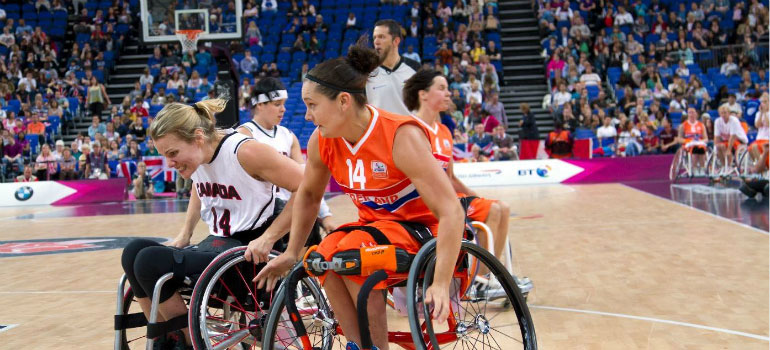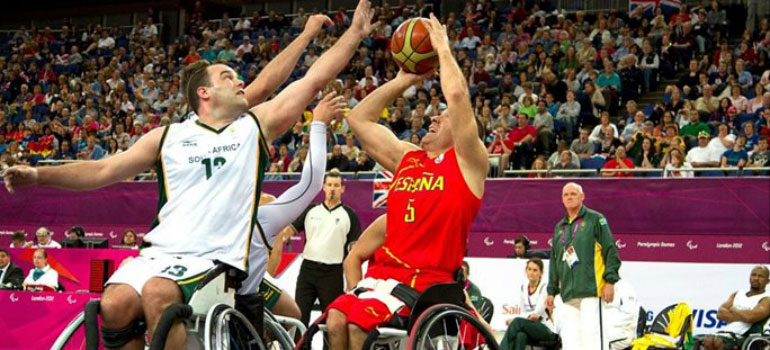
Wheelchair basketball is one of the most well-adapted sports, and is also one of the most widespread in the world. It is estimated that there are currently wheelchair basketball leagues and competitions in 75 countries, which gives us a good idea of its degree of social integration and level of competitiveness.
When was wheelchair basketball first invented?
To officially find the origins of wheelchair basketball, we need to journey back to the United States in 1946, when many of the professional US basketball players who had suffered injuries during World War II returned home and wanted to continue playing this sport, adapting it to their new needs.
Some time ago in 1944, German neurologist Ludwig Guttmann devised a rehabilitation program at Stoke Mandeville Hospital in Aylesbury, England, adapting some sports for wheelchairs for people with spinal cord injuries. Among these sports, we could find the antecedent of wheelchair basketball, which was known as wheelchair netball.
Wheelchair netball was introduced in the first Paralympic games in 1948, organized by Stoke Mandeville, and during the fifties, wheelchair basketball began to develop as we know it today.
Due to its great acceptance, in 1973 the International Stoke Mandeville Games Committee founded the first sub-section dedicated exclusively to this sport, and two decades later the International Wheelchair Basketball Federation (IWBF) became a worldwide organization.
Wheelchair Basketball: Basic Rules
Wheelchair basketball is one of the adapted sports which is most faithful to its original counterpart. In fact, the court dimensions, the basket and its height, the location of the three-point line, and the ball itself are the same as in Olympic Basketball. The duration of matches is also identical: four 10-minute quarters with two minutes of rest between quarters 1 & 2 and 3 & 4, and a 15-minute break at half-time.
The adaptation of wheelchair basketball has been designed taking into account the effects of moving in a chair. For example, if a player who has the ball touches the side line with any part of his chair, it would be considered out-of-bounds – a rule that has one exception: during free throws, the small wheels (never the large ones) may be on the throwing line.

Another adaptation affects the "steps" and "doubles" of traditional basketball. In wheelchair basketball, the player with the ball cannot give more than two consecutive bounces without passing or throwing the ball. Making the third bounce is therefore a fault, and the player is sanctioned for it. You also cannot throw the ball over the armrests.
Wheelchair basketball scoring is made conditional by the degree of disability of the athletes, and a score of 1 to 4.5 is applied to each player depending on their disability. The cumulative score of the team on the court can never exceed 14.5 points. The objective of this system is so that there is not one team which is more unbalanced than the other, due to having players with more or less mobility.
If you want to see the full rules, you can do so by visiting the International Paralympic Committee website.
The Chair in Wheelchair Basketball
In wheelchair basketball, the chair is very important as it is considered part of the player. The rules of this sport stipulate the size of the horizontal protection bars on the front and side of the chair, the height of the footrests so that they do not damage the playing field, anti-tip devices, and the size of the armrests, which are always fixed to the chair and can never exceed the leg or torso line during the game when sitting in a natural position.
As for the most technical part, wheelchair basketball chairs are provided with three or four wheels (two large at the back and one or two at the front) with a hoop hand support on each large wheel. Of course, 'extra' mechanisms are not allowed to facilitate driving, such as brakes or gearshifts, and at most two small wheels (casters) can be attached to the frame or rear axle. If the player needs to use a cushion, the measurements of this are also monitored: the maximum height from the floor to the top of the cushion is 63 cm or 58 cm, depending on the class of player.
The Quickie All Court sports wheelchair is sturdy, robust, and allows you to adjust the seat angle and center of gravity. The player can align his weight on the drive wheels and optimize the seat angles. The most demanding players can opt for the All Court Ti wheelchair, a fast, agile, and sturdy chair with a titanium frame. Which one would you choose?
Most of the stories here on LiveQuickie.com were submitted by readers. Do you have a story to tell? We'd love to hear it. Submit your story here.